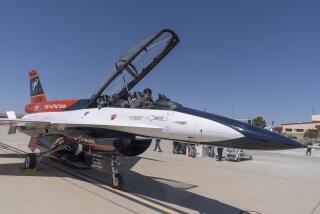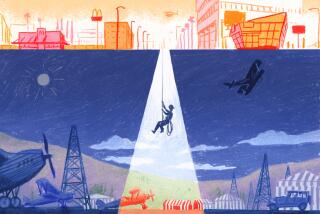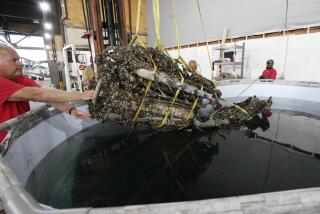A Flight of Fancy Turns Back Clock for Aviation World
- Share via
As the 53-year-old airplane, the only one of its kind still flying, headed east from Long Beach to Phoenix, co-pilot Pete Sherwin radioed the Los Angeles air traffic control center:
“TWA Flight 8002 checking in,” Sherwin reported. The old plane was lumbering along at 184 m.p.h. “What type of a TWA plane are you flying?” asked a controller curious about the slow speed of the aircraft.
“DC-2,” Sherwin replied.
“What’s a DC-2?” inquired the controller. “Forerunner to a DC-3,” Sherwin answered. There was a moment of silence before the controller uttered: “Oh!”
“He’s too young. He never heard of a DC-2, maybe not even a DC-3,” pilot Ron Reynolds said to his co-pilot.
This was a journey that turned back the clock for Reynolds, 54, who normally pilots jumbo 747s for TWA, and Sherwin, 53, who is usually in the cockpit of an MD-80. They were re-enacting a 1935 Los Angeles-to-St. Louis TWA flight on a restored 14-passenger, two-engine DC-2. In its day, the DC-2 was the most luxurious and fastest transport in the sky. Of course, its day was more than half a century ago.
Flight in 1935
In 1935, the regularly scheduled DC-2 left Los Angeles at 5 p.m. and arrived in St. Louis the next morning at 10:40, with stops at Winslow, Ariz.; Albuquerque; Amarillo, Tex.; Wichita, Kan., and Kansas City, Mo.
The re-enactment is taking 49 hours, including overnight stops in Albuquerque and Kansas City. Phoenix is substituted as a stop for Winslow, which no longer has a major airport. The plane took off from Long Beach Airport at 8:30 a.m. Monday and is scheduled to arrive in St. Louis at 9:30 a.m. PDT today.
Donald W. Douglas, founder of Douglas Aircraft Co., made one DC-1 as a prototype, then from 1934 to 1936 the company produced 156 DC-2s at its Santa Monica facility. TWA purchased 31 of the planes at $75,000 each and flew them until 1942.
Fokker ‘Lost a Wing’
“A Transcontinental Air Transport Fokker F-10 (made in Germany) lost a wing and crashed March 31, 1931, killing Notre Dame football coach Knute Rockne and seven others near Bazaar, Kan.,” said Ed Betts, 67, a TWA historian.
“It was determined that the Fokker crashed because of a wooden wing weakened with dry rot. A year later TAT, renamed TWA, asked Donald W. Douglas to design and produce a metal airplane that would fly over the mountains without crashing, even if one engine failed,” Betts said.
The resulting DC-2 cruised at twice the speed with twice the range--1,000 miles--of the Ford Trimotor, the most popular commercial aircraft of the time. Its success led to the production of more than 10,600 DC-3s manufactured by Douglas from 1935 through 1945. The DC-3, the successor aircraft, was wider and longer, with 21 passenger seats, but the same engine configuration.
Those aboard the re-enactment flight included Dan Colburn, 66, who flew the restored plane on its first test flight, TWA flight attendants Ginnie Hall, 33, and Jara Humbert, 34, as well as aviation historians, members of the Douglas Historical Foundation who restored the DC-2, plus representatives of the McDonnell Douglas Corp., TWA and the media.
The only DC-2 still flying was the 77th built. It was delivered to Pan Am March 17, 1935. The plane later was in passenger service for Mexicana Airlines and Aviteca Guatemala. From 1952 to 1971, it was used by the U.S. Forest Service to airlift smoke jumpers to fires.
Then it was turned over to the Donald Douglas Museum, but sat at the Santa Monica airport for 12 years. In 1982, the Douglas Historical Foundation leased it from the Donald Douglas Museum and renovated the aircraft at the McDonnell Douglas plant in Long Beach.
It took five years and $200,000 to restore the DC-2 to like-new condition.
“It’s like driving a car without power steering,” pilot Reynolds said. “It gives you a good feel for what those guys went through who flew them.”
For the passengers, the flight was very smooth, albeit noisy. And the nostalgia couldn’t be beat.
More to Read
Inside the business of entertainment
The Wide Shot brings you news, analysis and insights on everything from streaming wars to production — and what it all means for the future.
You may occasionally receive promotional content from the Los Angeles Times.










